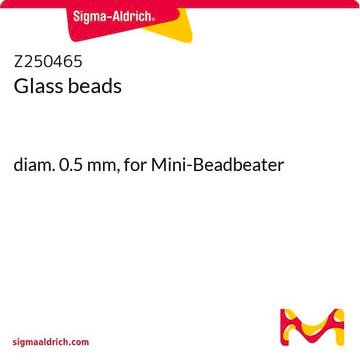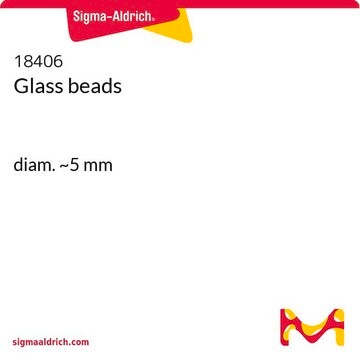G1152
Glass beads, acid-washed
710-1,180 μm (16-25 U.S. sieve)
Synonyme(s) :
Glass Beads
Se connecterpour consulter vos tarifs contractuels et ceux de votre entreprise/organisme
About This Item
Code UNSPSC :
41102422
Nomenclature NACRES :
NB.22
Produits recommandés
Taille des particules
710-1,180 μm (16-25 U.S. sieve)
Application
Acid-washed glass beads have been used:
- in the extraction of proteins from antigen-expressing transgenic lines of Nicotiana tabacum L.
- to extract DNA of Candida albicans from human and murine blood samples
- to measure lipid yield from microalga C.homosphaera by adopting different methods of cell disruption methods
Code de la classe de stockage
11 - Combustible Solids
Classe de danger pour l'eau (WGK)
nwg
Point d'éclair (°F)
Not applicable
Point d'éclair (°C)
Not applicable
Équipement de protection individuelle
Eyeshields, Gloves, type N95 (US)
Faites votre choix parmi les versions les plus récentes :
Certificats d'analyse (COA)
Lot/Batch Number
Vous ne trouvez pas la bonne version ?
Si vous avez besoin d'une version particulière, vous pouvez rechercher un certificat spécifique par le numéro de lot.
Déjà en possession de ce produit ?
Retrouvez la documentation relative aux produits que vous avez récemment achetés dans la Bibliothèque de documents.
Les clients ont également consulté
Katarina Damjanovic et al.
Microbial ecology, 79(3), 706-719 (2019-08-23)
Coral-associated bacteria are critical for the well-being of their host and may play essential roles during ontogeny, as suggested by the vertical transmission of some bacteria in brooding corals. Bacterial acquisition patterns in broadcast spawners remain uncertain, as 16S rRNA
Continued expression of plant-made vaccines following long-term cryopreservation of antigen-expressing tobacco cell cultures
Van E J and Keen P.
In Vitro Cellular & Developmental Biology. Plant, 45(6), 750-757 (2009)
Novel strategy for microalgae cell disruption and wet lipid extraction by employing electro-Fenton process with sacrificial steel anode
Wanniarachchige P, et al.
Bioresource Technology (2022)
Evaluation of a digital microfluidic real-time PCR platform to detect DNA of Candida albicans in blood
W. A. Schell
European Journal of Clinical Microbiology & Infectious Diseases : Official Publication of the European Society of Clinical Microbiology (2012)
Sarah L Sokol et al.
eLife, 7 (2018-05-23)
Most eukaryotic parasites are obligately heteroxenous, requiring sequential infection of different host species in order to survive. Toxoplasma gondii is a rare exception to this rule, having a uniquely facultative heteroxenous life cycle. To understand the origins of this phenomenon
Notre équipe de scientifiques dispose d'une expérience dans tous les secteurs de la recherche, notamment en sciences de la vie, science des matériaux, synthèse chimique, chromatographie, analyse et dans de nombreux autres domaines..
Contacter notre Service technique













